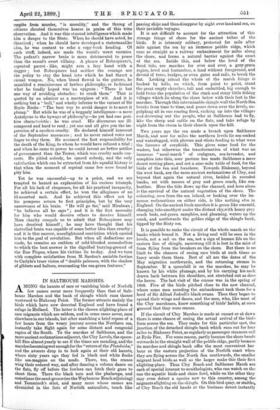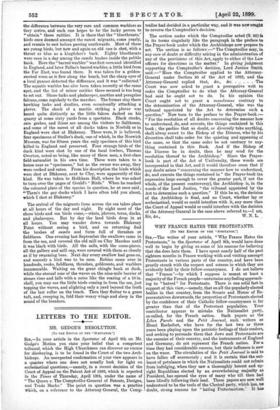IN SALTHOUSE MARSHES. A MONG the haunts of rare or vanishing
birds of Norfolk few names occur more frequently than that of Salt- house Marshes and the bank of shingle which runs thence westward to Blakeney Point. The former attracts mainly the birds which have now deserted England and have found a refuge in Holland. The latter is the chosen alighting-place of rare migrants which are seldom, and in some cases never, seen elsewhere in our islands, but after snatching a brief repose of a few hours from the weary journey across the Northern sea, instantly take flight again for some distant and congenial region of the South. To the marshes of Salthouse, and the more ancient reclamations adjacent, the Cley Levels, the spoon- bill flies almost yearly to see if the times are mending, and the marshesbecomingwet enough for the "return of the Plateleidce," and the avocets drop in to look again at their old haunt; where sixty years ago they fed in black and white flocks like sea-magpies on the muds. There, too, the cranes wing their ordered way, and after dancing a solemn dance on the flats, fly off before the fowlers can fetch their guns to shoot them. There the black tern and the phalarope, and sometimes the sand-grouse (on the Weybourne Beach adjoining) and Temminck's stint, and many more whose names are chronicled in the lists of Norfolk naturalists, touch like passing ships and then disappear by night over land and sea, on their invisible voyages.
It is not difficult to account for the attraction of this strange fringe of shore for the ancient tribes of the birds. It is intensely solitary, protected for mile after mile against the sea by an immense pebble ridge, which runs as straight as a railway embankment for miles along the shore, and forms a natural barrier against the onset of the sea. Inside this, and below the level of the flood tide, are marshes for ever and ever, a grey-green region, level and featureless, a land without foreground, and devoid of trees, bridges, or even gates and rails, to break the flat. Looking inland the whole of the marsh fringe is backed by hills, on which, from point to point, stand the great empty churches, tall and embattled, big enough to hold twice the population of the stark and stony little fishing villages which lie along the shore below with their feet in the marshes. Through this interminable shingle wall the North Sea breaks from time to time, and pours down over the levels, en- gulphing all in one roaring flood, rushing up into the villages and drowning out the people, who at Salthouse had to fly, like the sheep and cattle on the flats, and take refuge by night from the storm in their church upon the hill.
Two years ago the sea made a breach upon Salthouse Marsh, and now for miles the northern levels lie sea-soaked and waterlogged, with plovers and stints feeding in what were the furrows of cornfields. This gives some food for the waders, but otherwise the transformation of what was an immense " meal-marsh " of crabgrass, sea-lavender, and samphire into thin, sour pasture has made Salthouse a mere desert resting-place, and not a nine-mile table of food, for the birds of the fen and foreshore. Towards Blakeney, beyond the west bank, are the more ancient reclamations of Cley, and beyond that again the natural river, bedded in rounded banks, set with masses of grey and green orach, like sea- heather. Here the tide flows up the channel, and here alone is the survival of the natural vegetation of the shore. The colouring, seen from the sea inland, or looking over the im- mense reclamations on either side, is like nothing else in England. On the ancient fresh marshes it is green like emerald, changing into amethyst under the distant sky,with hoary grey orach beds, red-green samphire, and gleaming, waters up the creek, and northwards the golden ridge of the shingle bank, tipped by the flinty sea.
It is possible to make the circuit of the whole marsh on the banks which bound it. Not a living soul will be seen in the levels, not a sail on the sea, not a sign of human life on the eastern line of shingle, narrowing till it is lost in the mist of foam flying from the breakers on the shore. But there is no limit to the chances of seeing rare birds at such times as fancy sends them there. Best of all are the dates of the May migration northwards, and the returning stream in September. If a spoonbill is on the marshes, he may be known by his white plumage, and by his carrying his neck drawn back between his shoulders, not stretched out as does the heron. The last visit of the cranes was in the spring of 1898. Five of the birds pitched close to the new channel, where some men mending the embankment took them for a herd of Sir Alfred Jodrell's black swans. Then they began to spread their wings and dance, and the men, who, like most of the Cley marshmen, know something of birds' habit; at once guessed that they were cranes.
If the circuit of Cley Marshes is made at sunset or at dawn there is some chance of seeing the actual arrival of the birds from across the sea. They make for this particular spot, the junction of the detached shingle bank which runs out for four miles to Blakeney Point, as regularly as passenger steamers call at Ryde Pier. For some reason, partly because the shore bends outwards in the straight wall of the pebble ridge, partly because its marshes and shingle bank offer the most convenient har bour at the eastern projection of the Norfolk coast when they are flying across the North Sea southwards, the smaller migrant land birds as well as the larger make this their first alighting-place. Thus Cley Beach and Salthouse Marsh are each of special interest to.ornithologists, who can watch on the one the aquatic birds and shore fowl, while on the other they may even detect a species new to this country, among the migrants alighting on the shingle. On this bird quay, or staithe, of Cley Beach the old hands at the business detect instantly the difference between the very rare and common warblers as they arrive, and each one hopes to be the lucky person to "obtain" these rarities: It is there that the " bluethroats," birds once deemed amongst the rarest migrants, come yearly, and remain to rest before passing southwards. 'Most of these are young birds, but now and again an old one is shot, with a throat as blue as a kingfisher's back: Eighty bluethroats were seen in a day among the suceda bushes inside the pebble bank. Here the "barred warbler" was first seen and identified En England, and later Pallas's barred warbler, a little bird from the Far East, was found there. It was taken for a golden- crested wren as it flew along the beach, but the sharp eyes of a local gunner detected the difference, and it was "collected." The aquatic warbler has also been taken recently at the same spot, and the list of minor rarities there secured is too long to set out. Shore-larks and phalaropes, martins and peregrine falcons, come regularly to the marshes. The former stay there hawking larks and dunlins, even occasionally attacking a plover. The shock of a martin striking a plover was heard quite distinctly as the little falcon dashed on his quarry at some sixty yards from a spectator. Black storks, care grebes, and ibises are among the visitors to Salthouse, and some of the rarest of all ducks taken in Norfolk or in England were shot at Blakeney. These were, it is believed, four specimens of Steller's duck, one of which, in the Norwich Museum, was for fifteen years the only specimen of this bird killed in England and preserved. Four strange birds of the duck kind were shot by one of the local fowlers, Thomas Overton, noted as being, like many of these men, a first-class field-naturalist in his own time. These were taken to a house near as "specimens," but as the owner was away, they were cooked and eaten. From his description the birds which were shot at Blakeney, next to Cley, were apparently of this kind. He was taken to Holkham Hall, where he was asked to turn over the pages of Gould's "Birds." When he reached the coloured plate of the species in question, he at once said " Them's the gay ducks which I have often told you about, which I shot at Blakeney."
The arrival of the migrants from across the sea takes place at all hours of the day and night. By night most of the shore birds and sea birds come,—stints, plovers, terns, ducks, and phalaropes. But by day the land birds drop in at all hours. You may wander down towards Blakeney Point without seeing a bird, and on returning find the bushes of suada and furze full of thrushes or fieldfares. One evening last September the swallows came in from the sea, and covered the old mill on Cley Marshes until it was black with birds. All the sails, with the cross-pieces, all the gallery and mill cap, were covered with them as closely as if by swarming bees. Next day every swallow had gone on, and scarcely a bird was to be seen. Robins came over in hundreds, rooks, fieldfares, thrushes, goldcrests, and warblers innumerable. Waiting on the great shingle bank at dusk, while the eternal roar of the waves on the nine-mile barrier of stones rises and falls with a noise like the roaring of a 10 in. shell, you may see the little birds coming in from the sea, just topping the waves, and alighting only a yard beyond the froth of the last roller on the beach. Then they flutter to a grass tuft, and, creeping in, fold their weary wings and sleep in the sound of the breakers.







































 Previous page
Previous page